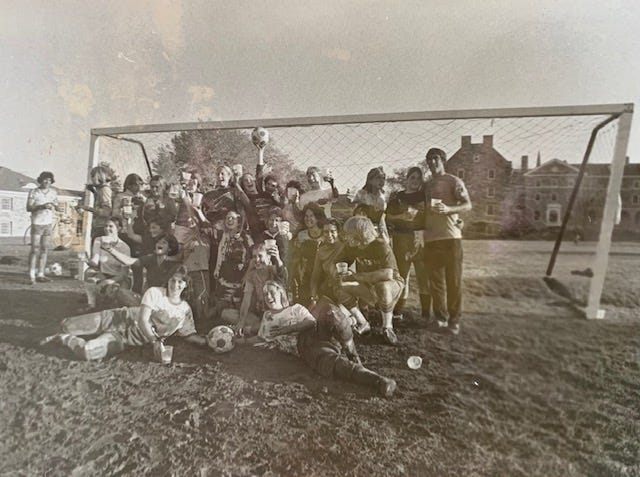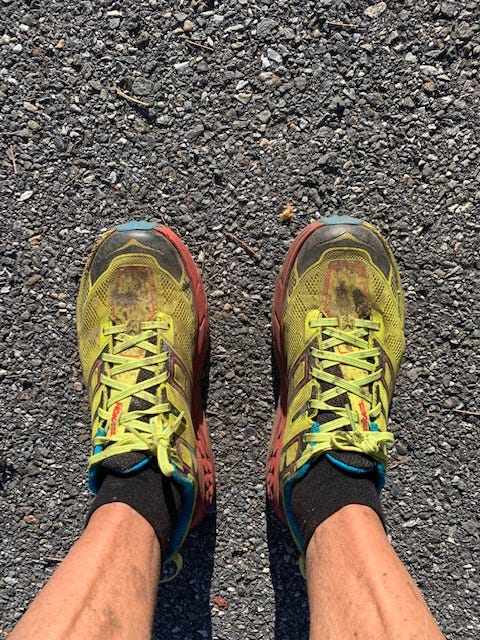Superman and the Fall Line
Or, finding the line between caution and daring
I’ve never been very good at falling. I am in fact so bad at it that I have injured myself even while practicing falling. Years ago, I briefly played goalkeeper for my over-40 soccer team. I was warming up before the match, practicing diving for the ball. On my very first dive to the left, I separated my shoulder. I am—let’s repeat it—not very good at falling.
I suppose few of us actually enjoy the sensation of hitting the ground right in the middle of whatever it is we’re doing. Walking, cycling, running, skiing, shoveling our icy driveways. But I believe some people are better at landing, somehow able to turn their tumbles into graceful rolls and maybe even come bouncing right back up again onto their feet. I’ve witnessed falls like this with my own eyes. I’ve seen my son trip going downhill on a hiking path, only to do an instinctive mid-air somersault and land on his feet, facing the way he’d been going. I think his backpack must have helped propel him around, but it was still an astonishing little athletic moment. I’ve seen my husband come off his cyclocross bike and somehow be back in the saddle in what seems like the same instant, his hands never leaving the bars.
I’ve never had that kind of agility. I was never the kid who could do handstands or handsprings (my god, those kids!). Whenever I had to do a forward roll, I felt as though my body was all angles, refusing to tumble, while everybody else seemed made to spin. One of my three soccer-related concussions in fact came from a tussle with the opposing goalkeeper that sent me to the ground as she won the ball and I spun backwards, my head unfolding awkwardly from my body to slam back against the sod.
But last summer, I had a new kind of fall. I was trail running and tripped on something while moving at a decent little clip (for me). I tried to pull out of the fall, like an airplane trying to come up out of a stall. I flung my hands behind me to shift my inertia away from the ground where it was heading. And at some point, I realized, as I took about three lunging steps forward to try to catch myself, that it wasn’t going to work. Instinctively, I then flung my arms out in front of me like a baserunner coming into home plate and I slid into the ground, stretched full-out, chin up. That particular fall banged my knees up pretty good, and caused some scrapage on one hand. But I was otherwise unhurt.
About a month later, it happened again. I tripped again, over some tiny rock in the trail that I hadn’t noticed as I came down a hill, and again I tried to save myself, and again at the last minute flung my arms out in front and dove (where was this diving ability when I was playing keeper!?). That time I tore a hole in my shorts, but again I was scraped and bruised but unhurt. And finally, it happened just two weeks ago during a six-hour trail race. That particular superman slide did knock the wind out of me and led me to take it slow for the next lap in the woods. But again—you see where this is going—I was unhurt.
It’s possible that I’ve become good at falling. Or that I have given in to some strangely flawed instinct and am doing this superman position when it would actually be smarter and better to roll some other way. Who knows. The main point is that: a) I am still falling b) I will continue to fall. But what do all these falls mean? (And I haven’t even mentioned all the falls I’ve had off a mountain bike lately.) Because, being a writer, I can’t help but hold these things up to the light and examine them. What does it mean to fall—as an athlete, as a creative person, as a human going about their daily business?
I learned to ski when I was three, when I was so low to the ground that I was surely making regular contact with the snow. By the time I was around ten, still skiing mostly with my parents, we began to count falls. The test of how well you’d skied that day was how few times you had fallen. My mother was particularly invested in this concept and was quite proud of a day in which she fell perhaps only once. Thus began a period of years in which I was a more cautious skier than I should have been. I played it safe, I never pushed my limits, I avoided icy patches (hard to do in New England). Sure, I didn’t get hurt, but I also didn’t develop much as a skier. It wasn’t until I was in my late twenties that I began to let go of the fear of falling and began to really push myself. No longer worrying about some tally of tumbles, I could dig my edges into a turn and get that wonderful sensation of torque that pushes you along the fall line.
Great term, that: fall line. The line that gravity takes down a ski slope—gravity being the thing a good skier wants to play with, not avoid. To become a better skier, I had to embrace falling and embrace the fall line, not shy away from it.
There are dangers to embracing the fall line, though. Of course there are. Because like a non-superhuman person (my superman-pose falls notwithstanding), I can only do this to a point. We non-superhuman people have to find the line between caution and daring. Too cautious, and we don’t improve. Too daring, and we get badly hurt. Six years ago, skiing at an area where every trail had been groomed so smooth there was no challenge to it, I caught a ski edge while going over 35 miles an hour and plummeted about thirty yards while tumbling head over heels and ended up with my fourth concussion. Since then, I’ve stopped skiing quite that fast. I’d rather ski a mogul trail, anyway, where the bumps slow me down but provide a different challenge. In skiing, now, I know my line between caution and daring, and it’s right there.
What about the rest of life? My daughter worries about my falls. When I report one of these adventures from a trail run or a mountain bike ride, she will say: “You fall a lot, lady.” She says it, I believe, both as worry and as reminder. We both know that, now that I’m over 60, I’m nearing that age when a fall can be a big deal. We know that in elderly people, a fall can break a hip, and a broken hip can lead to inactivity which can itself lead to greater health problems. We also both know that my mother was about 85 years old when she slipped on a polished marble floor in her apartment, while wearing three-inch heels (three-inch heels), and broke her hip. But we also both know my mother was using that same hip and leg a mere two months later to depress the clutch on her stick-shift car that she drove around Athens (yes, she should never have been driving, but that’s another story). I am confident none of my loved ones want me to really stop doing these things that might cause a fall. I also understand—and agree with—the idea that you have to find that line between daring and caution and then keep assessing and adjusting it with every passing year.
I am, of course, speaking figuratively as well as literally here. The beauty of taking risks and courting falls in creative work is that, honestly, the stakes are very low. Why not try something new in your work? Why not experiment with form, or voice, or structure? Why not commit to a project you might otherwise hesitate to embrace? Unless you face persecution or grave emotional trauma (which sadly many creatives do), what have you got to lose for trying?
There is resilience in falling. Just as there can be resilience in recovery from injury. There are many ways in this life to tumble but still land on your feet. The key is, I think, to leave your feet in the first place.
How do you think about falling? What risks do you take, and how do you calculate them?






This topic comes up often among those aging who don’t want to be sidelined by injury. A balancing act between comfort level and pushing beyond comfort level works for me. I never want to limit myself, but I may start out conservatively and build from that while building confidence. A recent example is skating, I needed a few times around the rink to build my confidence before I was ready to work on technique and speed. I couldn’t help think that ice is hard and could take me out for a while if I fell hard or flatten one of the kids skating circles around me. It always inspires me to read of people’s adventures at any age and makes me want to do more. Thanks for the inspiration!
One goal, once the contagion slows and courses begin again, is to restart tai chi. Terrifically meditative with the added bonus of improving balance. Loved doing it way back when. Look forward to restarting.
One trick my movement instructor taught back in grad school was an aikido roll. Go with the energy of the momentum, think of yourself round versus angular, and roll through the fall diagonally across the back, leg tucked allowing the momentum to bring you upright. If heading backward, bend one leg with the foot toward the center of your body and roll along one side of the spine toward your shoulders.
Wonder if I can still do that? Use it getting off the floor when exercising, but reversed? Hmmm.